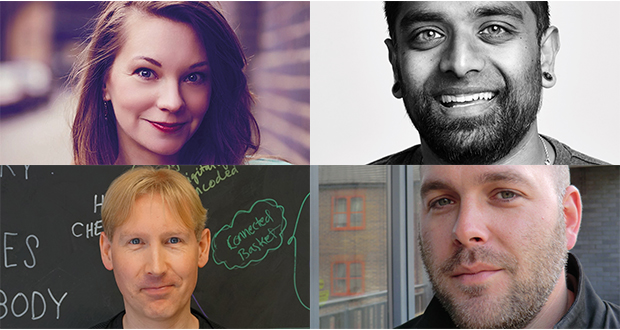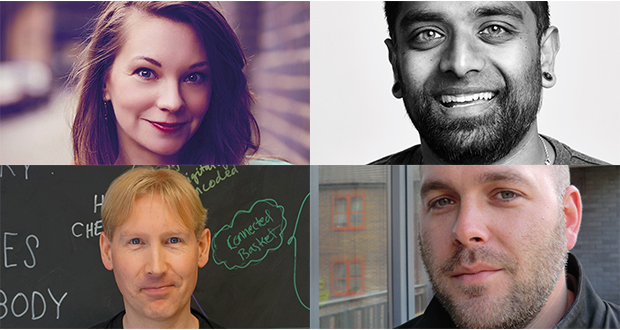
Sanj Surati, digital atelier and founder, Tiger Heart
“Many are hot currently. Augmented Reality (AR) – the overlay of visual media over the view of a user’s sightline using a portable AV device like a smartphone or a headset. Virtual Reality (VR) – the immersion of a full virtual world on to a user via a headset as opposed to an overlay. Mixed Reality (MR) – the same as AR. Or is it? I think it is. Holography – the illusion of projecting a volumetric image into a real space. Artificial Intelligence (AI) – the computation of thoughts and decisions made by a computer similar and sometimes more superior than a human mind. Neurological components that plug into the mind, and cybernetic elements that enhance the subjective human form.
AV professionals are going to face using them, either out-of-the-box or with bespoke implementations. Each developer or producers’ goal when utilising new tech is usually different.
I believe training and the right infrastructures to support these new technologically advanced AV solutions are the way to go.”
Amelia Kallman, futurist, speaker and author
“What I’m really excited about is web AR – the biggest trend I’ve seen so far in 2019. It gets away from having to download anything to have an AR experience, which has always created friction when it comes to retail. To simply be able to point your camera at something and then have the augmented experience is really cool. And to me, why this could be a game changer is because it completely disrupts the customer journey.
For years I’ve been working with retailers who’ve tried to bring together the digital, ecommerce end with the physical, bricks and mortar end of the business. This is a kind of solution for that because you can create things like AR scavenger hunts in stores so you get people motivated to go around, interact with products, collecting free coupons say and all of a sudden you’re having this experience that you can share on social media. You can then integrate this with payment systems because we’re already paying with a mobile phone using WeChat and Apple Pay. You then have a seamless customer journey through the mobile, but in-store.”
Evan Grant, founder, seeper
“I’m looking at AR with ride systems and gaming, assisted learning, mobile retail; VR – immersive telepresence; and MR – reality overlay and feedback with responsive environment. Misuse of the word ‘holography’ continues. True holography is still emerging. There are lots of different approaches to creating a true system but none have scaled yet.
There are responsive environments/experiences via sensor tech, such as gesture control, interactive surfaces, proximity sensing, Wi-Fi meshing and other positional tracking. Voice activation/bots are another – virtual assistants, celebrity and historical figures (animatronic projected figure tech), home and office automation, and hands-off interaction.
A lot of people are just saying these words all the time because it’s the new cool thing to do but it’s all about storytelling, narrative and creating compelling experiences really. The key challenge is finding brave clients who want to do something new. The bleeding edge will always be bespoke. The advantage of this approach is to tailor, own and have exclusivity on a unique new technology.”
Matthew Drinkwater, head of Fashion Innovation Agency, London College of Fashion
“We’re trying to change the mindset of a student body. It’s hugely important that retailers develop a pathway using 3D to develop experiences, but the industry is not particularly well trained in the use of 3D as a design tool.
We’ve started a lot of work beginning to show to the fashion industry that creating in 3D will eventually enable the industry to create assets a lot more simply.
You can then begin to imagine what sort of experiences would be appropriate for consumers – say, how consumers react to 3D assets on a website, or through a headset via augmented or mixed reality.
You can imagine an entirely new computing platform for us which supports how we help designers make, show and sell their collections. London Fashion Week would be an entirely different experience.
We were very fortunate to spend a number of years working with Lucasfilm and its immersive entertainment division, ILMxLAB to develop a new vision for the industry where within decades mixed reality glasses will be consumer facing. And at that point when you can add digital content from the real world, imagine what new business models could be on offer. We need access to technology and to start working externally with partners.
We’ve just finished a year working alongside Microsoft where amazingly the company opened its doors to allow us to work with AR, MR and wearable computing, and we’ll do another round of that this year.
It will remain a vital component of how we educate a new generation in the creative industries with direct access to technology, working closely with creative technologists to build a new future for the industry. But it’s not something that we can do by ourselves. It has to be done in partnership.”

